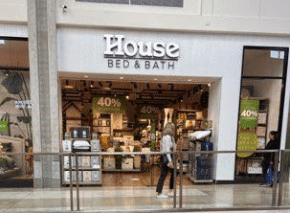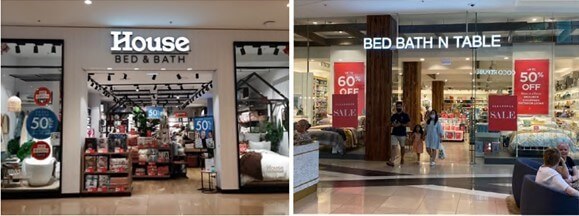The owner of the popular ‘House’ stores, engaged in misleading and deceptive conduct when it took part of Bed Bath ‘N’ Table’s branding for its new homewares store, the Federal Court has found.
In Bed Bath ‘N’ Table v Global Retail Brands Australia[1] , Justice Rofe found that GRBA’s decision to brand its soft homewares stores as ‘House Bed & Bath’, was “in the realm of wilful blindness as to the prospect of confusion arising from the adoption of a name that appropriated two words from one of its largest, if not the largest, competitor.” – Bed Bath ‘N’ Table.
Background
Since 1976, BBNT has operated stores in Australia using its namesake as a trade mark selling soft homewares. It is also the owner of four Australian trade mark registrations for BED BATH ‘N’ TABLE, and since the ‘90s has used the trade mark shown below including on store signage.

Soft homewares comprise textile goods, bathroom products, household linen, kitchen ware and items such as cushions, throws, vases and candles.
For about forty years, GRBA has operated stores selling kitchenware and hard homewares under the HOUSE trade mark and various sub-brands.
The parties had co-existed for many years and were familiar with each other’s stores. Each accepted the other party had a substantial and independent reputation in their respective trade marks.
On 14 May 2021, GRBA launched its first House Bed & Bath (House B&B) store selling soft homewares at Westfield, Doncaster, Victoria. The store had the signage shown below.

Unlike its traditional ‘House’ stores which had a particular cluttered discount look, the Doncaster store appeared similar to other soft homewares stores such as BBNT and Adairs. Features of these stores included large front windows showing one or two beds made up in ‘Hamptons’ style. A House B&B store and BBNT store are shown below.

BBNT immediately demanded GRBA rename its store but when GRBA opened a further store in June 2021, BBNT commenced proceedings.
BBNT’s claims
BBNT claimed that GRBA’s conduct in using HOUSE B&B on its stores and website:
- infringed the BBNT trade mark registrations for BED BATH ‘N’ TABLE;
- constituted misleading and deceptive conduct breaching the Australian Consumer Law. In particular, that the House B&B brand and stores were associated with, approved by or licensed by BBNT ; and
- amounted to passing off.
GRBA submissions
In its defence, GRBA argued:
- Its use of ‘BED’ and ‘BATH’ were purely descriptive;
- The terms were used as category or navigational description for homewares; and
- The use of ‘BED’ and ‘BATH’ in conjunction with the well-known HOUSE trade mark did no work in designating the commercial origin of the stores.
Misleading and deceptive conduct
BBNT argued that in light of its reputation, GRBA’s adoption of the similar branding either conveyed that:
- the two businesses had formed an alliance or arrangement to sell similar products; or
- had a co-branding relationship; or
- there was a mis-association with consumers believing the businesses were one and the same or part of the same corporate group.
In its defence GRBA also argued that BBNT did not enjoy an independent reputation in the get-up of its stores, or the ordinary English words ‘bed’ and ‘bath’ when divorced from the BBNT marks. It argued its mark and its stores were readily distinguishable from those of BBNT.
In assessing whether GRBA ‘s conduct was misleading or deceptive, the Court considered both the broad and immediate context of use of House B&B to be relevant. This broader context included:
- BBNT’s reputation and the factual distinctiveness of its trade mark established over 40 years of trading, currently in 167 stores.
- The appearance of BBNT’s stores;
- The co-location of rival soft homeware stores in close proximity in shopping centres;
- GRBA’s reputation in its House brand established over 40 years, with current stores numbers of about 140 store;
- The appearance of GRBA’s House stores which had a ‘discount’ look, unlike the style of soft homewares stores;
- No other retailers in Australia used ‘BED’ and ‘BATH’ in their store name or on external signage so BBNT has 40 years of trading with this unique use; and
- Other soft homewares retailers used ‘bed and ‘bath’ as category descriptors.
This immediate context included:
- The prominent use of ‘House’ in the House B&B mark and use on a soft homewares style shopfront;
- The difference in appearance between the ‘Hamptons style’ of the new House B&B stores and the cluttered, discount look of the typical ‘House’ store which was familiar to consumers.
Justice Rofe also considered it to be:
… highly relevant that when it adopted the House B&B mark, GRBA was aware of the existence of BBNT and its reputation in the soft homewares sector, as both had been operating in the broader homewares sector for around 40 years. When combined with a surprising lack of legal advice and the fierce determination not to change the name of the store when the prospect of confusion was first brought to GRBA’s attention, GRBA’s attitude to the possibility of confusion of House B&B with BBNT can only be described as one of wilful blindness. Although GRBA’s wilful blindness may not amount to an intention to deceive consumers, it provides a similarly “reliable and expert opinion on the question of whether [GRBA’s conduct] is in fact likely to deceive.
The evidence showed that GRBA had made a last minute decision to change its new store branding to House B&B but it had not sought legal clearance for its use. Just days before the first store opened, an email between GRBA’s Head of Brand and Media and its founder, stated they would ‘have Bed bath and table running scared’ then listed the possible names for consideration of HOUSE bed & bath, HOUSE BATH AND BED HOUSE BEDWORKS. Throughout the proceedings, GRDA’s witnesses denied it had derived the name from BBNT.
They attempted to explain the decision to adopt ‘BED’ and ‘BATH’ on the basis they were appropriate category descriptions. This was to try to undermine the inference that GRBA adopted the trade mark and get-up of BBNT because it knew its use was likely to deceive or cause confusion. The Court didn’t consider the evidence from GRBA’s witnesses on this point truthful or plausible stating:
… Mr Lew selected the name “House BED & BATH” from the other two options presented to him by Ms McGann (“House BATH AND BED” and “House BEDWORKS”) because, although all three options employed category descriptions of the products sold in store, “BED & BATH” “rolls off the tongue” more easily than the other two names. The suggestion that “BED & BATH” “rolls off the tongue” is in all likelihood the result of the 40 years of use of those words in Australia by BBNT as part of its name. It is not the natural order for reference to those words. That is, the usual sequence is to have a bath before you go to bed, especially for small children. Notwithstanding that BBNT does not have an independent reputation in the words “BED BATH” alone, BBNT’s longstanding reputation in its name which included the words “bed” and “bath” (and in that order) is undoubtedly part of the reason that those words appealed to GRBA, which could leverage off that well-known pairing of words in entering a new market for the first time.
The Court found the similarities in the stores’ appearance to reinforce the connection between BBNT and House B&B. It also considered the evidence of consumer confusion BBNT led, whilst on its own had very little weight, strengthened the inference that GRBA had engaged in misleading and deceptive conduct and made a false representation of an affiliation or association between its stores and BBNT.
____
[1] Bed Bath ‘N’ Table Pty Ltd v Global Retail Brands Australia Pty Ltd[1] [2023] FCA 1587

